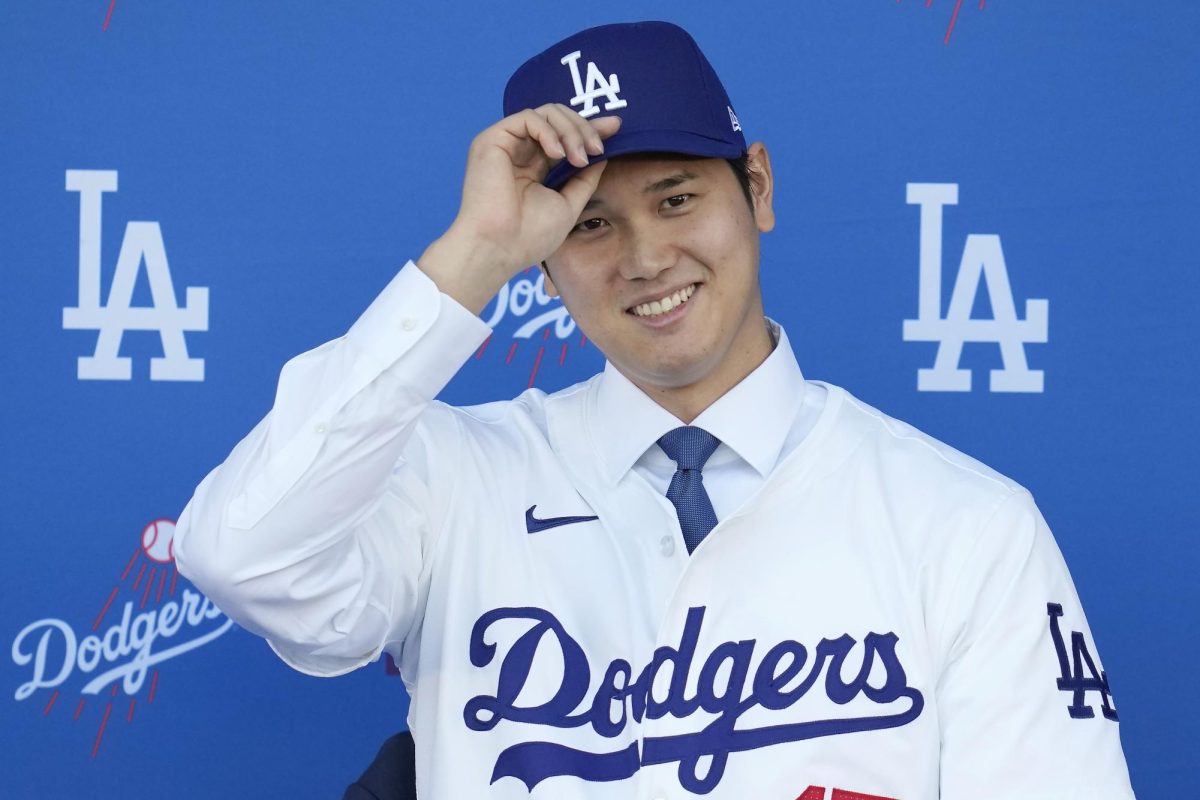The second that the Texas Rangers stopped celebrating their first-ever World Series championship, fans, journalists and pundits alike turned to the next big MLB story: the free agency of Shohei Ohtani, two-time AL MVP Award winner.
Ohtani came off an MVP season for the Los Angeles Angels, in which he led the league in home runs, OPS and total bases. He was hailed as the “greatest free agent of all time,” by Fox Sports.
It’s easy to see why. His value is game-breaking. He’s the first player in over a century to pitch and hit at an all-star level. According to Baseball Reference, in his 2023 campaign, he hit 84% better than the average batter and threw 42% better than the average pitcher.
“He’s a unicorn,” Hall of Fame shortstop Derek Jeter said. “For him to be able to [pitch and hit] is pretty remarkable.”
And now that Ohtani has signed with the Los Angeles Dodgers, the cross-town rival of his former Angels, for 10 years and $700 million, those fans, journalists and pundits are all left picking up the pieces of his messy free agency.
The contract itself is unlike any other seen in professional sports, primarily because of its value. The $700 million sum is the largest in sports history, edging out soccer legend Lionel Messi’s deal with FC Barcelona in 2017, which was worth $674 million, according to ESPN.
What’s unique is how the contract is structured. In MLB, contracts are usually split evenly over their term, making their average annual value consistent throughout the contract’s length.
For larger contracts, payments may be front-loaded or back-loaded, meaning that the earnings may steadily increase or decrease at a fixed rate. These contracts are uncommon, however, and are usually only given out to star players who command hundreds of millions of dollars.
Even rarer are deferred payments, where the value of the contract isn’t paid out in full during a player’s time with the team, and the money is instead given to the player a longer time after the contract is up. For example, Bobby Bonilla and Ken Griffey Jr. make millions per year, despite having retired in 2001 and 2010, respectively.
Ohtani’s contract is deferred, which isn’t surprising given its large size. Had it not been deferred, the Dodgers would have been paying the Japanese superstar $70 million a year, almost double the second-highest AAV in MLB.
What is surprising is how much money is deferred. For 10 seasons after the contract is over and Ohtani is free to move on to a new team, the Dodgers will be paying him $68 million a year. That means, while he’s playing for the Dodgers, Ohtani will be making just $2 million per season.
To put that in perspective, Yankees outfielder Aaron Judge, who won the AL MVP in 2022, is making twice in one season what Ohtani will be making over the next decade.
So, why would Ohtani take this pay cut? It’s important to look at his past. In the last six seasons, the amount of time he spent with the Angels, 28 teams made the postseason. Two did not: the Detroit Tigers and the Angels.
Ohtani has never played in the MLB postseason. He has never played for a winning team. He has never finished above fourth in his division.
The Dodgers haven’t missed the playoffs since 2012. They’ve had 13 straight winning seasons. They haven’t finished fourth in their division since 2010.
“I do prioritize winning,” Ohtani said at his signing press conference. “That’s at the top of my list.”
His pay cut will give the Dodgers the ability to continue to pursue some of the top players in free agency, something that the Angels could not do well in his time with them.
Right now, the Dodgers are one of the most talented teams in baseball. Hitters Mookie Betts and Freddie Freeman placed second and third in NL MVP voting, respectively, and the pitching staff is almost as strong, boasting veterans like Clayton Kershaw and Tyler Glasnow as well as young arms in Bobby Miller and Dustin May.
And while the two-way Ohtani will be limited to only hitting this season, the promise of having the former Cy Young vote-getter in the rotation for nine seasons will excite any organization.
But how exactly did he end up with the Dodgers? Most contending teams were in on him, and though teams like the San Francisco Giants and Toronto Blue Jays didn’t end up with Ohtani, they were certainly front-runners to sign him and offered similar contracts to what he signed with the Dodgers.
The latter seemed closer to signing him than just about any other organization, at times even more likely than the Dodgers.
On Dec. 8, it was reported by JP Hoornstra that Ohtani would be taking his talents to a third country and would sign to play in Toronto. The same day, internet sleuths began to track a plane from Los Angeles to Toronto, believing that he was on route to announce his deal with the Blue Jays.
But he wasn’t on the plane. Canadian businessman Robert Herjavec was. Ohtani was at home in LA with his dog.
But for a moment, a single day, the Blue Jays faithful thought they landed the biggest free agent in the history of professional sports.
Instead, the next day, he announced that he would be wearing Dodger blue for the next 10 seasons.
There’s just one thing that may limit Ohtani’s future: injuries. In August, he tore his UCL and would require his second Tommy John surgery, which will keep him off the mound next season. The injury will not limit his dominance at the plate, however.
Now that the biggest fish in the ocean of free agency has been caught, those very same fans, journalists and pundits, will move on to MLB’s next big story while awaiting the dawn of the next season and the Dodgers’ new Ohtani era.


